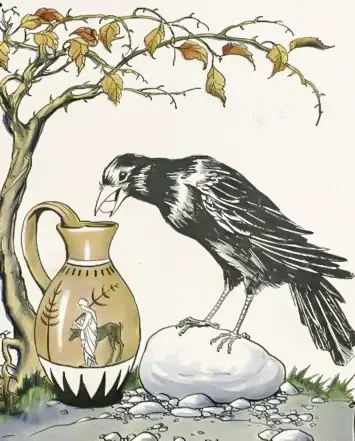The Crow & The Pitcher
Illustrates Resourcefulness, Incremental Problem Solving, and Collective Ingenuity
In many Agile environments, teams are often handed complex problems with limited resources. Rather than waiting for perfect conditions or top-down solutions, high-performing Agile teams learn to work with what they have. The classic Aesop fable The Crow and the Pitcher1 beautifully captures this idea. It teaches us that persistence and small, strategic actions can turn a near-impossible situation into success.

During a long dry spell, a thirsty crow flew through the fields in search of water. At last, it spotted a tall pitcher with a small amount of water at the bottom. But the crow's beak couldn't reach far enough to drink.
The crow tried tipping the pitcher but it was too heavy. Flying away felt like failure. Instead, the crow gathered small pebbles and dropped them into the pitcher one by one. Slowly, the water rose. After many trips, the crow was finally able to drink.
What once seemed out of reach became achievable, not through force or luck, but through creativity and patient effort.
Lessons Learned
Incremental Progress is Real Progress
The crow didn't solve its problem in one go. It broke down the challenge and solved it bit by bit. Agile teams thrive by doing the same, small deliverables, continuous improvement, and focus on what can be done next.
Ingenuity Outweighs Constraints
Instead of giving up, the crow adapted. Agile coaches help teams see beyond limitations and find creative ways forward, even in the face of missing tools, unclear direction, or shifting priorities.
Systems Change with Small Inputs
Each pebble seemed insignificant on its own, but together they changed the system. Agile practices like refactoring, backlog grooming, and DevOps automation often feel small at the time but compound into big impact.
Resourcefulness is a Team Asset
A single crow made a difference through repeated effort. Now imagine what a team of crows could do. Empowering teams to experiment and take ownership of solutions is far more powerful than waiting for executive decisions.
Coaching Tips
- Use the Pebble Metaphor in Retrospectives: Ask teams, “What's one pebble we could drop this sprint that might move us closer to our goal?”
- Spot Ingenuity: Highlight when teams solve problems creatively with limited resources. Reinforce that mindset.
- Model Small Wins: Demonstrate how small changes (new Daily Scrum format, better refinement, reduced WIP) can produce measurable outcomes.
- Teach Systems Impact: Use the water-level image to explain cumulative improvements like CI/CD, test coverage, or tech debt repayment.
Agile is rarely about brute force. It's about clever adaptation, learning as you go, and embracing the power of small steps. Like the crow, Agile teams must look at what they can do now and act, knowing that each small improvement gets them closer to their goal.


